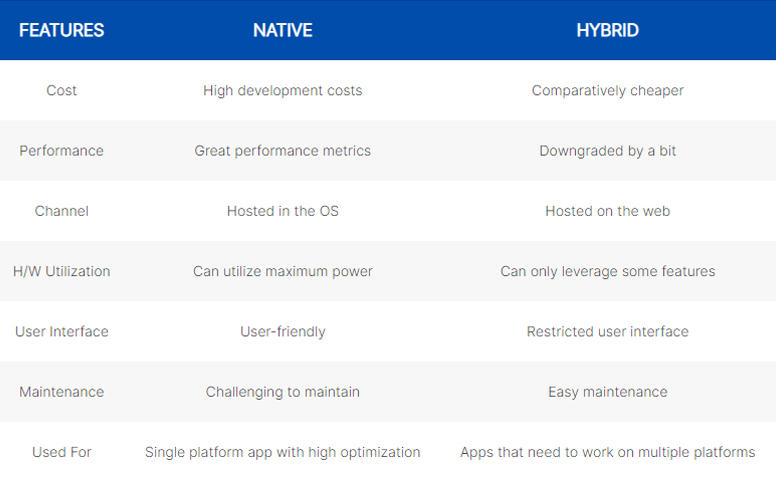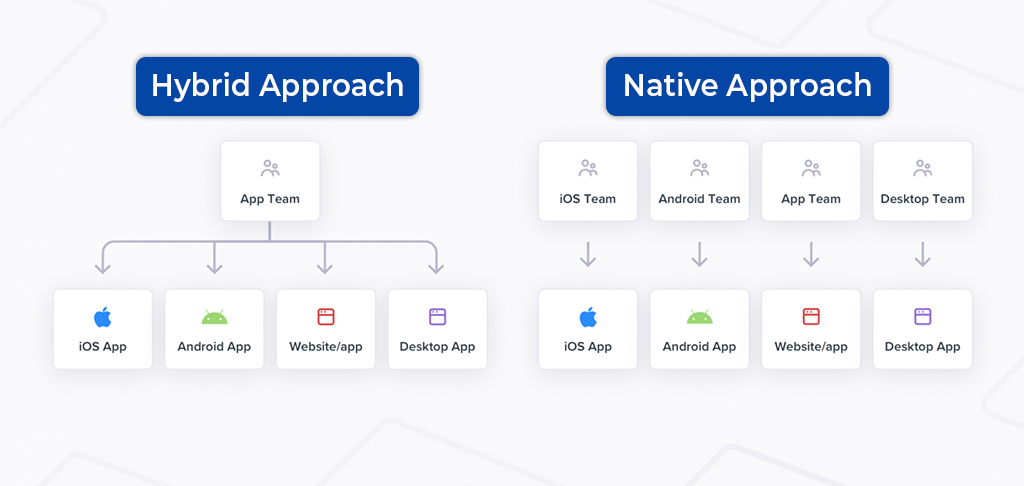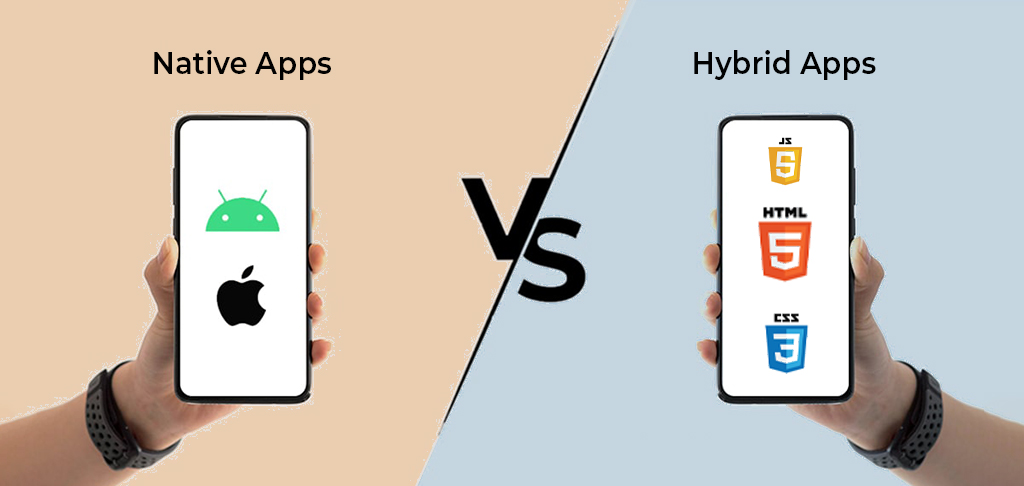Mobile app development has become the norm. Businesses are recognizing the potential of this segment to become successful brands.
Could you imagine? Research by Statista reports the quarterly number of mobile applications downloaded in 2022 is 28.3 billion on Google Play Store, and 8.5 billion on the Apple app store.
The numbers are significant. But, do you notice the massive difference between the downloads?
Now, It may sound a little strange that Android app downloads are more than iOS app downloads, even though iOS accounts for 53.66% of the market, and Android accounts for 46% of the market.
Both the operating systems are great, and in demand, so why not produce applications for both of them? Why does Hybrid (iOS & Android) app development clash with native app development? – We are going to discuss everything about this.
This is one of the common challenges among thriving businesses. Therefore, deciding which mobile app platform would meet their requirements, should pass through following questions first:-
- What’s the objective behind building the app?
- What’s the budget allocated for the app?
- What features are required in the app?
- What speed and methodology are requested for app development?
- Whether outsourcing an agency or a developer
This blog post helps you understand the differences between hybrid and native apps. It also explains the pros and cons of each platform to help you decide which is best for your mobile app project.
Table of contents
What is a Native mobile application?
- Technology Stack
- Characteristics
- Benefits of native apps
- Drawbacks of native apps
- Examples of top native mobile apps
What is a hybrid mobile application?
- Technology stack
- Characteristics
- Benefits of hybrid apps
- Drawbacks of hybrid apps
- Examples of top hybrid mobile apps
- Debunking the top 3 myths about hybrid mobile apps
- Tabular difference between Native and Hybrid mobile apps
- The difference between Native and Hybrid app development approaches
- Native vs Hybrid app: Based on other relevant factors
- Conclusion
What is a Native mobile application?
Native mobile applications are designed to be used on a specific platform or device. Because they are specifically designed for one type of phone and its operating system, they can use the phone’s special hardware and software.
In contrast to mobile cloud applications or web applications, native applications have better performance and access to the latest technologies like image processing.
There are two main mobile operating system platforms: iOS, made by Apple, and Android, created by Google. Native applications are coded in a language that is designed for mobile devices and their operating systems. Developers create Android-native apps using Java, whereas developers create iOS apps using Swift or Objective-C.
Native mobile applications are those that are designed to run on a specific platform, such as iOS or Android. They tend to have fast execution and a high degree of accuracy. Their user interface controls and layouts are also more accessible, as well as faster. However, an iOS-based app will not run on Android, and vice versa.
This means that you will have to create different versions of your software for each platform, which can be expensive and require a larger team size if you want to release your software on both iOS and Android simultaneously.
Advisory read: Expanding native app to the web – The comprehensive guide
Technology Stack
Native apps for Android and iOS require different frameworks.
Android native app uses:-
- Kotlin: Kotlin is a programming language that was created to be used with Android. Google recommends Kotlin for developing native Android apps, and it can be used as an alternative to the Java compiler in Android Studio. Kotlin makes it possible to write apps more quickly.
- Java: This language is used for mobile apps, desktop apps, and web development. It gives developers access to a useful library that lets them use the various Android OS features.
iOS native app uses:-
- Swift: Swift is the new programming language from Apple that replaces Objective C. It is faster and easier to use than Objective-C. Many of today’s popular native iOS apps are written in Swift because it makes them run smoother and look better.
- Objective-C: A programming language that is very popular and has been used for a long time. It has many libraries which you can use to help with your programming, and it works well with other programming languages.
Characteristics of native mobile apps
Following are the primary characteristics of a native mobile application:-
- Native apps are reliable.
- Native apps are simple, faster in performance, and ensure a smooth user experience.
- Native apps support both, offline and online operations.
- Features of native apps can be used most optimally.
Benefits of native mobile apps
- It is a versatile app that takes advantage of the features of a smartphone.
- Responsive software performance.
- Comes with push notifications functionality.
- Native apps offer a user interface that is more similar to the user experiences of the OS.
- The quality of Native apps can be assured through ratings in the App Stores.
Drawbacks of native mobile apps
- Native apps involve multiple code bases because different devices require different coding. This is the case for Android apps and iOS apps.
- It costs more money to have different developers create code for different platforms.
- A lot of time is spent creating different versions of the software for different platforms.
Examples of top native mobile apps
- Spotify
- Magento 2 POS
- Pokemon Go
- Tesla
What is a Hybrid mobile application?
Hybrid development allows you to write code once and have it work on many different platforms. This is done by combining the best features of both web-based apps and native apps.
Hybrid apps are built with technology that is common on the web, like HTML5, CSS, and JavaScript. But they also use native plugins to do things that regular web apps can’t do. This makes them work just like a regular app, but they don’t need to be coded twice.
This means that your app can use features of the device like the camera, fingerprint sensor, facial recognition, and file storage. You only need one codebase to do this, which makes it cheaper to develop and maintain than a native app.
Hybrid apps are created by combining a web view with separate packages that can be submitted to app stores. This gives the appearance of two apps, but in reality, there is only one.
Technology stack
The following are the top three hybrid app development frameworks:-
- React Native: This is Facebook’s framework that is open-source and cross-platform compatible. It ensures a simple user interface, high performance, and short development times.
- Xamarin: Microsoft supports this open-sourced framework and it is regularly updated. Xamarin is good for simple apps and easy to maintain. It is usually the best choice for business-driven projects.
- Ionic: Ionic creates mobile apps with technologies like JavaScript, CSS, and HTML. It is easy to learn and has a simple interface. However, it can be challenging to maintain. With the advent of React Native development, the popularity of Ionic has faded.
Characteristics of hybrid mobile apps
- Following are the primary characteristics of a hybrid mobile application:-
- Hybrid applications can work even if the device doesn’t have an internet connection.
- Hybrid apps can connect with the device’s storage system and use features of the operating system.
- Hybrid apps easily integrate web-based services.
- Hybrid apps have a built-in browser that helps you access dynamic online content.
- Hybrid apps can be developed more quickly and at a lower cost than traditional apps. This saves time and money.
- Hybrid apps are easy to use and manage.
- Hybrid apps have a cross-platform user interface (UI).
- Hybrid apps allow you to have a single codebase that works on multiple platforms. This makes it much easier to support your app in the long run.
Benefits of hybrid mobile apps
- They can operate on both Android and iOS since they share a single code base. It may also run on most devices thanks to the consistent user interface (UI).
- Hybrid applications are more scalable because they use the best parts of both mobile and web applications. They also require less time to build than separate mobile and web applications, because they only use one codebase.
- Hybrid apps are cheaper to make because they share a single code base and don’t require as many developers as Native apps. They also take less time to develop.
Drawbacks of hybrid mobile apps
Hybrid apps are similar to web apps, so they need a good network connection to work well.
Because of their architecture, hybrid mobile apps rely on plugins to access the features that are built into the mobile device.
Hybrid applications do not offer the same great user experience as native applications do. This is because the interface for both Android and iOS users is compromised when a hybrid application is created. If too much focus is given to developing the Android interface, the iOS user experience will be compromised, and vice versa.
Creating a Hybrid app can be difficult because it doesn’t fix some of the problems that are common in Native app development. In order to create a Hybrid app, you need a Native app developer who can help you with the process.
Many businesses face the common challenge of deciding whether to develop a native or hybrid application. Both options have benefits, but the best option for a particular business depends on its specific requirements and purpose.
Examples of top hybrid mobile apps
- Discord
- NerdWallet
- BMW App
Debunking the top 3 myths about hybrid mobile apps
Hybrid apps have been criticized by the native app community. However, with new technology and hybrid apps becoming more popular, there are a few worth highlighting.
1) The user experience could be better. People have different opinions about what is good, so it is a personal preference. The UI looks like the device, but this makes it difficult to customize for your brand. When creating a hybrid app, it is important to have a partner with strong UI and design abilities. This will ensure that the user experience is positive and effective. Some of the most popular hybrid apps, such as Twitter and Instagram, are developed this way. Users often find the experience to be on-par or better than native apps.
2) Hybrid apps need an internet connection to work. This is not always the case. Hybrid apps are stored on your device like native applications. You can use them without an internet connection, and data will be saved locally on your device.
3) Hybrid applications have poor performance because they rely on Apple and Android web browsers to operate. Mobile devices didn’t have the power to create truly polished web experiences until very recently. This is no longer the case with more advanced devices, so hybrid performance for most applications is now comparable to that found in native apps.
Native vs Hybrid apps – Tabular Difference

Hybrid vs Native apps – Development Approach

Difference between Native app and Hybrid app
Based on user experience
Native applications provide the best user experience because they are specifically designed for a specific app store. They take into account the hardware capabilities and screen size of the device. In contrast, hybrid apps have one code base for all platforms and cannot offer good user experiences. This is in comparison to native apps.
Based on cost and time of development
Hybrid applications are less expensive to develop and require less time. Furthermore, hybrid apps are simpler to maintain. They have a single code base, whereas native apps have multiple code bases because they are tailored for different target platforms.
Based on the platforms you want your app to operate on
If a company wants to put its app on multiple platforms, like Android, Apple, and Windows, it can make a website or hybrid app. The company can develop and publish a website or hybrid app with a single code base. It can then distribute that software to various platforms. Native applications, on the other hand, require different programming for each platform, such as different languages for different types of devices.
Based on the utilities the app offers
For businesses looking to launch a paid app on the App Store, native apps are the best option because they have a better user interface. Free applications may be built using a hybrid app, which is less desirable from a user experience perspective.
Based on app distribution across various app stores
If a company wants to distribute its app through the App Store, it must develop a native mobile app instead of a mobile-optimized (responsive) web application that may be accessed through the device’s web browser.
Based on device features accessibility
If you want to use your phone’s features, like the camera or GPS, you can go with both native or hybrid app. Just avoid web app as they cannot easily use those features on phones.
Based on developers’ availability
If your company needs to be on many platforms, but you don’t have developers who know how to make apps for mobile devices, you may want to consider making a hybrid mobile app. This means that you will use the same programming skills you know, like JavaScript, HTML, and CSS, to make an app that works on multiple platforms.
Conclusion
Different methods have different benefits and drawbacks. A native approach will often provide the most benefits for a company’s bottom line. However, it is still important to consider the advantages and disadvantages of hybrid and native approaches.
Hybrid applications are very appealing because they are fast to market, use one codebase, and work on multiple web platforms. However, they can be difficult to maintain over time as users complain about different elements of the user interface or performance issues.
Native apps have specific functions that are unique to the type of device on which they run. Additionally, native apps offer the best security, performance, user interface and access to all native APIs.
In other words, the company may have to spend more money up front, but in the long run they will save time and money by offering a great user experience and an industry standard app performance.
Each approach has its pros and cons, but a native approach will have the biggest benefits for a company’s bottom line.
What are your opinions on this? Would you prefer a Native or a Hybrid app development? Connect with our team and share your requirements.






